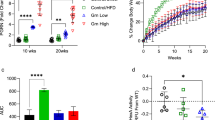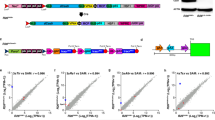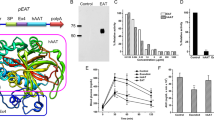Abstract
Angiotensin-I-converting enzyme (ACE) is involved in the synthesis and degradation of important bioactive peptides. The ACE gene has a 287-bp insertion/deletion polymorphism that controls ACE expression through a mechanism that remains elusive. In this study, we found that the 287-bp polymorphic element of the ACE gene, a member of the AluYa5 sub-family of Alu elements, codes for an RNA molecule that controls the levels of ACE mRNA. Transient transfection of a plasmid containing a CMV promoter upstream of the ACE polymorphic element resulted in significant expression of an AluYa5 RNA and reduced ACE mRNA expression as well as ACE enzymatic activity in AD 293 cells. The AluYa5 element also independently reduced the expression of other genes, regardless of whether these genes harbored Alu elements within their genomic context. Interestingly, the CMV promoter was not required for the expression of the AluYa5 element in AD 293 cells. The 287-bp sequence was sufficient to produce AluYa5 RNA and led to a significant reduction in ACE gene expression. Moreover, the removal of an 11-bp fragment of the 3′ end of the ACE polymorphic sequence, which is specific to this particular AluYa5 element, did not prevent this element from being expressed but did affect its ability to target ACE expression. Thus, the expression of the AluYa5 polymorphic element within the ACE gene could explain why patients carrying the ACE insertion polymorphism have reduced risk of developing several chronic diseases.
This is a preview of subscription content, access via your institution
Access options
Subscribe to this journal
Receive 6 print issues and online access
$259.00 per year
only $43.17 per issue
Buy this article
- Purchase on Springer Link
- Instant access to full article PDF
Prices may be subject to local taxes which are calculated during checkout









Similar content being viewed by others
References
Cushman DW, Cheung HS. Spectrophotometric assay and properties of the angiotensin-converting enzyme of rabbit lung. Biochem Pharmacol. 1971;20:1637–1648.
Bünning P, Holmquist B, Riordan JF. Substrate specificity and kinetic characteristics of angiotensin converting enzyme. Biochemistry. 1983;22:103–110.
Kuoppala A, Lindstedt KA, Saarinen J, Kovanen PT, Kokkonen JO. Inactivation of bradykinin by angiotensin-converting enzyme and by carboxypeptidase N in human plasma. Am J Physiol Heart Circ Physiol. 2000;278:1069–74.
Almeida SS, Barros CC, Moraes MR, Russo FJ, Haro AS, Rosa TS, Alves MF, Pesquero JB, Carmona AK, Bacurau RF, Araújo RC. Plasma kallikrein and angiotensin I-converting enzyme N- and C-terminal domain activities are modulated by the insertion/deletion polymorphism. Neuropeptides. 2010;44:139–143.
Rigat B, Hubert C, Alhenc-Gelas F, Cambien F, Corvol P, Soubrier F. An insertion/deletion polymorphism in the angiotensin I-converting enzyme gene accounting for half the variance of serum enzyme levels. J Clin Invest. 1990;86:1343–1346.
Suehiro T, Morita T, Inoue M, Kumon Y, Ikeda Y, Hashimoto K. Increased amount of the angiotensin-converting enzyme (ACE) mRNA originating from the ACE allele with deletion. Hum Genet. 2004;115:91–96.
Amorim CE, Nogueira E, Almeida SS, Gomes PP, Bacurau RF, Ozaki KS, Cenedeze MA, Silva Filho AP, Câmara NO, Araújo RC. Clinical impact of an ace insertion/deletion and kinin B2 receptor+9/-9 polymorphisms in the prognosis of renal transplantation. Biol Chem. 2013;161:369–377.
Almeida SS, et al. Carbamazepine inhibits angiotensin I-converting enzyme, linking it to the pathogenesis of temporal lobe epilepsy. Transl Psychiatry. 2012;13:e93.
Pérez-Oller L, Torra R, Badenas C, Milà M, Darnell A. Influence of the ACE gene polymorphism in the progression of renal failure in autosomal dominant polycystic kidney disease. Am J Kidney Dis. 1999;34:273–278.
Chen Y, Dong S, He M, Qi T, Zhu W. Angiotensin-converting enzyme insertion/deletion polymorphism and risk of myocardial infarction in an updated meta-analysis based on 34993 participants. Gene. 2013;522:196–205.
McGrath DS, Foley PJ, Petrek M, Izakovicova-Holla L, Kolek V, Veeraraghavan S, Lympany PA, Pantelidis P, Vasku A, Wells AU, Welsh KI, Du Bois RM. Ace gene I/D polymorphism and sarcoidosis pulmonary disease severity. Am J Respir Crit Care Med. 2001;164:197–201.
Tsianos G, Sanders J, Dhamrait S, Humphries S, Grant S, Montgomery H. The ACE gene insertion/deletion polymorphism and elite endurance swimming. Eur J Appl Physiol. 2004;92:360–362.
Lander ES, et al. Initial sequencing and analysis of the human genome. Nature. 2001;409:860–921.
Alemán C, Roy-Engel AM, Shaikh TH, Deininger PL. Cis-acting influences on Alu RNA levels. Nucleic Acids Res. 2000;23:4755–4761.
Häsler J, Strub K. Alu elements as regulators of gene expression. Nucleic Acids Res. 2006;34:5491–5497.
Ponicsan SL, Kugel JF, Goodrich JA. Genomic gems: SINE RNAs regulate mRNA production. Curr Opin Genet Dev. 2010;20:149–155.
Smalheiser NR, Torvik VI. Alu elements within human mRNAs are probable microRNA targets. Trends Genet. 2006;22:532–536.
Lei H, Day IN, Vorechovský I. Exonization of AluYa5 in the human ACE gene requires mutations in both 3’ and 5’ splice sites and is facilitated by a conserved splicing enhancer. Nucleic Acids Res. 2005;33:3897–906.
Mariner PD, Walters RD, Espinoza CA, Drullinger LF, Wagner SD, Kugel JF, Goodrich JA. Human Alu RNA is a modular transacting repressor of mRNA transcription during heat shock. Mol Cell. 2008;29:499–509.
Fleming I. Signaling by the angiotensin-converting enzyme. Circ Res. 2006;98:887–896.
Panning B, Smiley JR. Activation of RNA polymerase III transcription of human Alu elements by herpes simplex virus. Virology. 1994;202:408–417.
Rosatto N, Pontremoli R, De Ferrari G, Ravazzolo R. Intron 16 insertion of the angiotensin converting enzyme gene and transcriptional regulation. Nephrol Dial Transplant. 1999;14:868–871.
Wu SJ, Hsieh TJ, Kuo MC, Tsai ML, Tsai KL, Chen CH, Yang YH. Functional regulation of Alu element of human angiotensin-converting enzyme gene in neuron cells. Neurobiol Aging. 2013;34:1921.e1–7.
Batzer MA, Deininger PL, Hellmann-Blumberg U, Jurka J, Labuda D, Rubin CM, Schmid CW, Zietkiewicz E, Zuckerkandl E. Standardized nomenclature for Alu repeats. J Mol Evol. 1996;42:3–6.
Mandal AK, Pandey R, Jha V, Mukerji M. Transcriptome-wide expansion of non-coding regulatory switches: evidence from co-occurrence of Alu exonization, antisense and editing. Nucleic Acids Res. 2013;41:2121–2137.
Jeck WR, Sorrentino JA, Wang K, Slevin MK, Burd CE, Liu J, Marzluff WF, Sharpless NE. Circular RNAs are abundant, conserved, and associated with ALU repeats. RNA. 2013;19:141–157.
Jády BE, Ketele A, Kiss T. Human intron-encoded Alu RNAs are processed and packaged into Wdr79-associated nucleoplasmic box H/ACA RNPs. Genes Dev. 2012;26:1897–1910.
Yakovchuk P, Goodrich JA, Kugel JF. B2 RNA and Alu RNA repress transcription by disrupting contacts between RNA polymerase II and promoter DNA within assembled complexes. Proc Natl Acad Sci USA. 2009;106:5569–5574.
Murphey LJ, Gainer JV, Vaughan DE, Brown NJ. Angiotensin-converting enzyme insertion/deletion polymorphism modulates the human in vivo metabolism of bradykinin. Circulation. 2000;102:829–32.
Lachurié ML, Azizi M, Guyene TT, Alhenc-Gelas F, Ménard J. Angiotensin-converting enzyme gene polymorphism has no influence on the renin-angiotensin aldosterone system or blood pressure in normotensive subjects. Circulation. 1995;91:2933–42.
Acknowledgements
We thank the members of the Department of Biophysics, Federal University of São Paulo, Brazil, for their support.
Funding
This work was supported by Fundação de Amparo à Pesquisa do Estado de São Paulo (FAPESP 2010/52477-7; 2015/20082-7).
Author information
Authors and Affiliations
Corresponding author
Ethics declarations
Conflict of interest
The authors state that they do not have any conflict of interests.
Electronic supplementary material
Rights and permissions
About this article
Cite this article
Mafra, F.F.P., Gattai, P.P., Macedo, M.M. et al. The angiotensin-I-converting enzyme insertion/deletion in polymorphic element codes for an AluYa5 RNA that downregulates gene expression. Pharmacogenomics J 18, 517–527 (2018). https://doi.org/10.1038/s41397-018-0020-x
Received:
Revised:
Accepted:
Published:
Issue Date:
DOI: https://doi.org/10.1038/s41397-018-0020-x
This article is cited by
-
Alu retrotransposons and COVID-19 susceptibility and morbidity
Human Genomics (2021)



